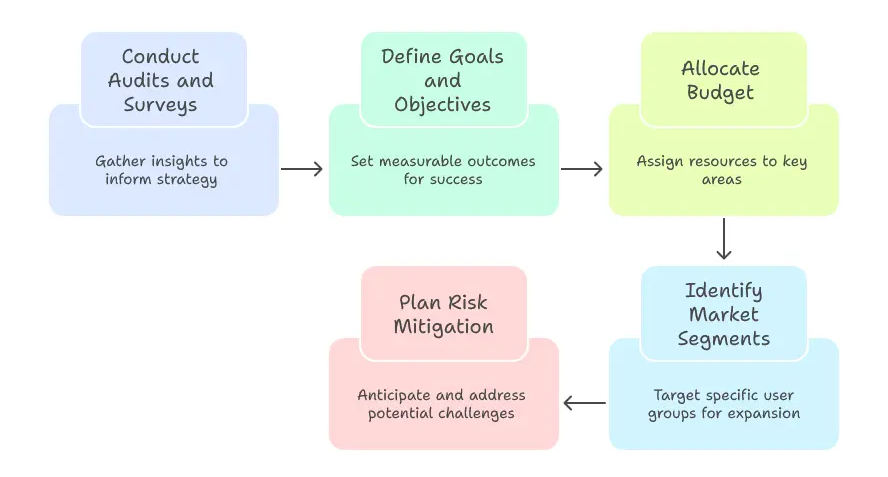How GrowthJockey is Helping EdTech Startups Scale Through Smart Product Strategy

The promise of an EdTech startup has people across boardrooms and classrooms invested. Every day, hundreds of millions of learners worldwide depend on digital platforms to expand their skills.
The global EdTech market is projected to reach USD 348.41 billion by 2030. Yet getting started with this rapidly evolving industry requires more than an EdTech startup idea. You need a partner who knows where specific industries fall short and how to build lasting learner loyalty.
At GrowthJockey, a strong product strategy is the solution to reversing these trends. We nurture startups and amplify education products with a data-driven strategy. Our organic growth approach goes beyond quick sign-ups to build learner loyalty.
In the sections that follow, we’ll show how our accelerator tackles different challenges that come with EdTech startups and give an insight into various methods you can use.
The reality of EdTech retention: Why most users disappear
According to Tracxn[1], 2,780 Indian EdTech startups shut down in the past decade (between 2015 and 2024). It’s no wonder that founders ask why EdTech startups fail.
Part of the challenge lies in usage patterns. Massive Open Online Courses (MOOCs), once held at high standards as the future of education, now see completion rates below 10%[2], with most learners dropping out before the first few modules.
When learners vanish so quickly, it’s difficult to build the momentum needed for word-of-mouth referrals, sustained engagement, or reliable revenue.
Several factors contribute to these retention hurdles:
-
Low usage and retention: Learners sign up on impulse but lack clear motivation or support to follow through.
-
Slow monetisation: Converting free users into paying customers can take months.
-
Resistance to change: Educators and institutions can be hesitant to adopt new platforms without a strong evidence of impact.
-
Intense competition: With thousands of similar offerings, standing out requires constant innovation and marketing budget.
-
Startup ecosystems: EdTech startups need to bridge the gap between a dynamic, sales-driven approach and education’s inherently deliberate, discussion-based methods.
-
Others: Equally important are data security measures and teacher training on new tools, areas that demand focused attention and resources.
GrowthJockey's approach to EdTech product strategy
A clear position in the market can make or break an EdTech venture. After all, 34% of startups fail because they miss the right product-market fit.
Our strategic positioning framework helps EdTech startups pinpoint their niche, plan new-tech integrations, and validate product-market fit, so their platform launches and also leads.
The mission is to motivate educators and learners with innovative solutions that improve teaching and learning experiences globally.
This mission guides every phase from initial idea to global rollout, while avoiding the pitfalls that cause too many startups to stall. Let’s see how:
1. Systematic planning methodology

A good EdTech product strategy starts with audits and survey insights, and then it rests on a well-thought-out plan. We recommend mapping out:
-
Goals and objectives: Define measurable outcomes (e.g., boost weekly active users by 25%).
-
Budget allocation: Assign resources to development, marketing, and support.
-
Market expansion tactics: Identify priority segments like K-12, upskilling professionals, or higher-ed.
-
Risk mitigation: Anticipate regulatory hurdles, platform scalability issues, or content licensing needs.
Learn more about this approach in depth in our guide to scaling EdTech startups
2. Structured ideation and validation
Rather than suboptimal brainstorming, the process centres on targeted research. Founders collaborate on rapid user interviews and small-scale pilots, whether testing virtual reality in EdTech or simple web prototypes, to validate assumptions and refine the product vision.
This approach is about testing ideas with real users and internally organising for execution.
3. Defining your market niche
Every successful EdTech VC begins by pinpointing where its platform fits within the crowd. Our team guides founders through a series of workshops and competitor analyses that help founders articulate their unique value.
Be it adaptive assessments, collaborative forums, or immersive virtual reality in EdTech, this clarity positions your validated idea against competitors and defines how you’ll show up in the market.
4. Platform development expertise
Studies show well-executed UI can increase conversions by up to 200% and UX by 400%[3].
This keeps educational platforms equipped with intuitive navigation and accessibility. Through A/B testing and analytics-driven feedback loops, your platform stays both scalable and user-friendly.
5. Hands-on mentorship
Founders gain access to a curated network of product strategists, curriculum experts, and experienced EdTech VCs.
Weekly workshops cover topics like pricing models, revenue projections, and scaling strategies. As a result, companies learn how to navigate investor conversations, build financial plans, and structure their teams for growth without losing educational integrity.
6. Technical and compliance guidance
Technical architects review each startup’s requirements, recommending everything from cloud-native architectures to analytics dashboards for tracking engagement.
Security specialists make sure data-protection measures meet institutional standards, while teacher-training modules help educators adopt new technologies with confidence.
7. Expert-led technology integration
Emerging immersive technology can transform learning if it is implemented thoughtfully. Specialists in simulation design and 3D content delivery can guide startups to avoid costly missteps and advise a better user experience from day one.

8. Learning from global leaders
GrowthJockey emulates case studies and market insights from the world’s top EdTech startups. Founders gain actionable lessons on product-market fit, go-to-market tactics, and organic growth strategies for EdTech by examining successes and setbacks.
With our VC network and hands-on mentorship, we help startups pitch like seasoned founders of a global EdTech startup.
9. Scaling with confidence
Once product-market fit and retention goals are met, we shift the focus to expansion. Strategic partnerships, like integrating with LMS providers or forging ties with educational institutions, are pursued to push student acquisition.
User engagement optimisation strategies that we use
Engagement drives retention, and interactive content can boost learner activity by over 50%. Below are our top strategies for transforming brief visits into lasting learning experiences.
1. Content strategy development
We help you deploy technology specific to EdTech to grow your business, including a content strategy. We mix multimedia formats (videos, infographics, and micro-learning clips), smart assessment engines, collaborative forums, and hyper-personalised learning paths.
Founders might wonder why they need interactive elements when they have good educational content.
Pro tip: Interactive content typically generates more than half the engagement as static formats, while short videos (30-120 seconds) keep learners’ attention most of the time.
By blending quizzes that adapt to student responses, peer-review forums, and bite-sized video explainers, you create a learning journey that feels alive and keeps users coming back.
2. Feature implementation
We understand the ins and outs of EdTech website development and app features. Our experts prioritise the features proven to bring in engagement:
-
Adaptive assessments: Questions adjust in real time to each learner’s level, maintaining challenge without frustration.
-
Collaborative tools: Integrated discussion boards and group projects foster peer learning and reduce drop-off.
-
Gamification modules: Badges, leaderboards, and progress trackers encourage healthy competition, and gamified apps see higher retention.
-
Personalised dashboards: Learners see tailored recommendations and progress insights, driving a sense of ownership over their education

3. Content and creative strategies
-
Storytelling with data and infographics: Real-world use cases paired with clear visuals help learners connect theory to practice.
-
Simulations and hands-on exercises: Interactive labs and scenario-based tasks let users apply concepts immediately, increasing completion rates and confidence.
-
AI-powered personalisation: Machine-learning algorithms analyse learner behavior to recommend next steps, creating truly custom learning paths that adapt over time.
Revenue growth strategies that work for EdTech
Profiting in EdTech through growth revenue is as crucial as keeping learners engaged. Below, explore two proven strategies: lead generation and nurturing, and freemium models that turn initial interest into lasting, ever-growing revenue.
1. Lead generation and nurturing
Immediate response: Quick follow-ups show prospects you value their time and keep them engaged, gently guiding them from initial interest to exploring your platform’s benefits.
Personalised sales teams: When reps personalise conversations around specific learner needs and challenges, discussions feel relevant and build trust, turning curiosity into commitment.
Email marketing and webinars: Well-timed drip emails with clear calls to action, paired with interactive webinars, let you showcase features, share success stories, and address questions.
2. Freemium model for acquisition and conversion
Offering core features for free lets users try your platform risk-free. On the other hand, reserving advanced tools for paid plans encourages upgrades and turns curious trial users into loyal subscribers.
Learn how 5 successful EdTech startups achieved revenue growth
Case study insights: GrowthJockey's EdTech transformation results
Cambridge School’s site suffered low visibility, slow load times, and minimal engagement. Organic traffic was minimal, with a few hundred visits per month.
Approach
GrowthJockey completely revamped the SEO funnel, rebuilt core web vitals, and deployed a content engine of 50+ campus and program pages.
We mapped high‑intent local keywords and optimised CTAs, internal links, schema markup, and site architecture. An analytics playbook using GA4, Intellysys - an intelligent data management platform, and Search Console guided every iteration.
Results
-
Traffic Surge: 8.1× growth in organic visits
-
Speed & Stability: Core Web Vitals scores improved by 65%
-
Content Scale: 50+ targeted pages launched
-
Engagement Lift: Sessions rose by 69.3%
-
CPA Reduction: Cost‑per‑admission fell 42%
-
Keyword Breakthrough: Top rankings for admission‑related searches
-
Evergreen Momentum: Monthly gains from 59.7% in January to 21.1% in July
Our team proved that aligning technical SEO, strategic content, and continuous data analysis creates a self‑reinforcing growth engine.
Fast‑loading pages increase user retention, and rich, localised content captures demand. Furthermore, ongoing analytics ensure priorities shift to the highest-impact fixes. Together, these elements turned over sustainable traffic, engagement, and enrolment efficiency for the school.
The GrowthJockey advantage: Why EdTech startups choose this partnership model
Building a successful EdTech startup means more than having a great idea. It requires mastering learner engagement, regulatory compliance, and ever-evolving technologies.
Lessons from experience: Founders without deep sector experience can easily overlook critical factors like personalised learning paths or secure data protocols, leading to stalled growth and frustrated users.
An accelerator bridges that gap by adding expertise directly into the startup journey. Our team guides you through translating data-driven roadmaps into action: from AI-powered personalisation and gamified assessments to seamless VR integrations.
From your first EdTech startup organisational structure to global expansion, we’re here to show you success. GrowthJockey’s incubation support in India, combining educational insight with startup agility, will help avoid common pitfalls.
FAQs on EdTech startups
1. What is the future of EduTech?
EdTech will be defined by AI-driven personalisation, immersive AR/VR experiences, and data-powered learning analytics. These will bridge skills gaps and expand user access. Collaborative partnerships and sustainable models will also lead to a trillion-dollar global education ecosystem.
2. What is the aim of EdTech?
EdTech seeks to democratice high-quality learning by making education accessible, adaptive, and scalable. It uses technology to tailor content to individual needs, improve outcomes through data insights, and close equity gaps, motivating educators and learners alike to participate.
3. Why is EdTech booming?
The EdTech industry is booming because of rapid digital adoption. Accelerated by pandemic-era remote learning, combined with affordable smartphones, rising upskilling demands, and strong government support, has encouraged EdTech’s growth.
Investors poured over USD 20 billion in 2024 alone, driving innovation across K-12, higher-ed, and corporate training.
4. Who are the unicorns in EdTech?
As of 2024, there are 14 global EdTech unicorns valued at nearly USD 40 billion, including India’s BYJU’s and Physics Wallah, plus global names like Coursera, Duolingo, Kahoot!, and Yuanfudao.








